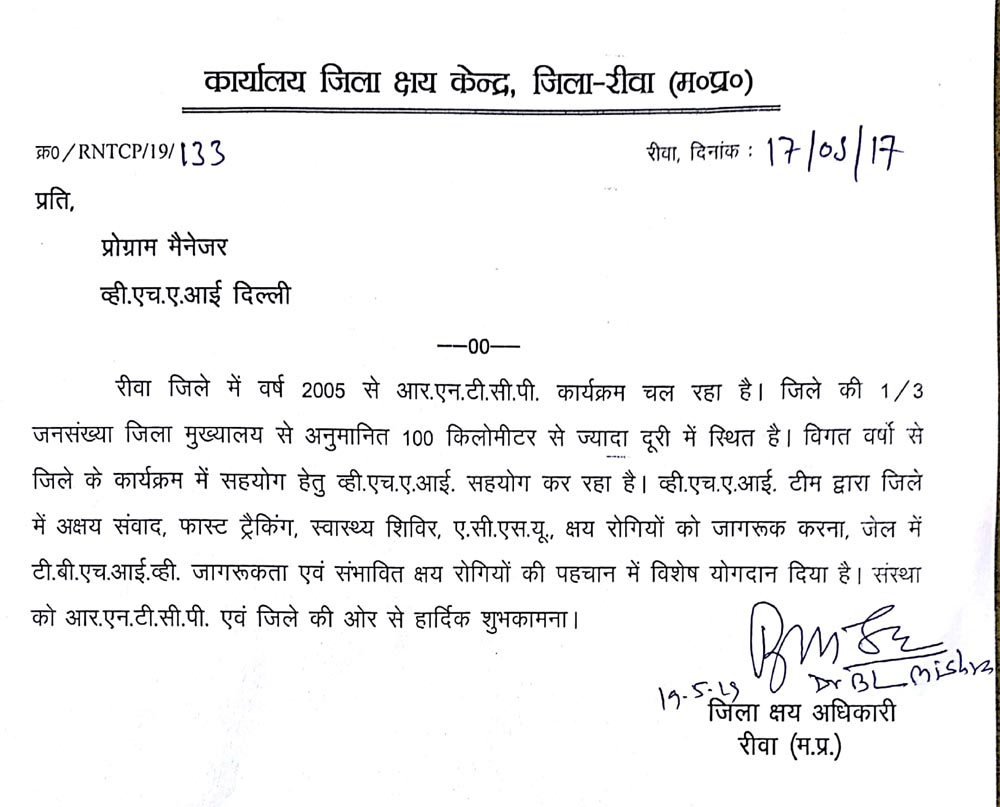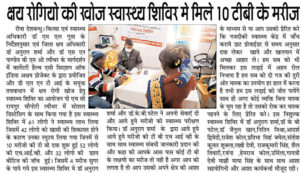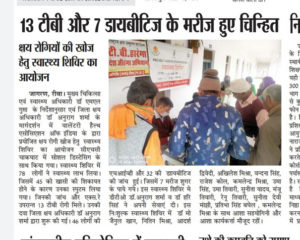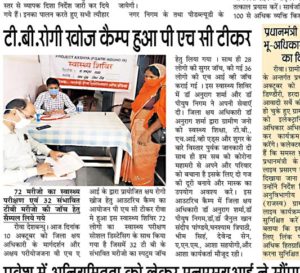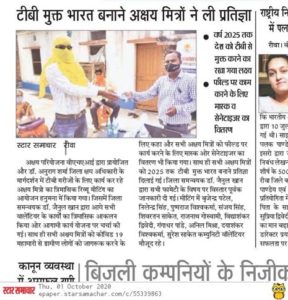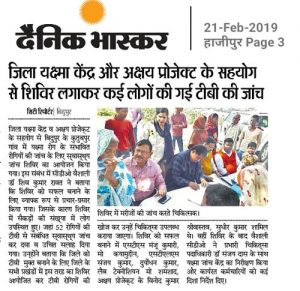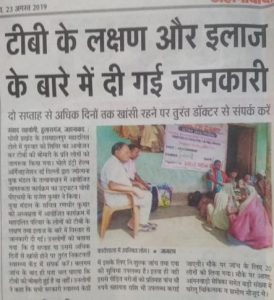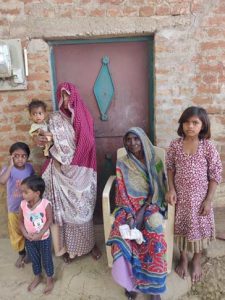




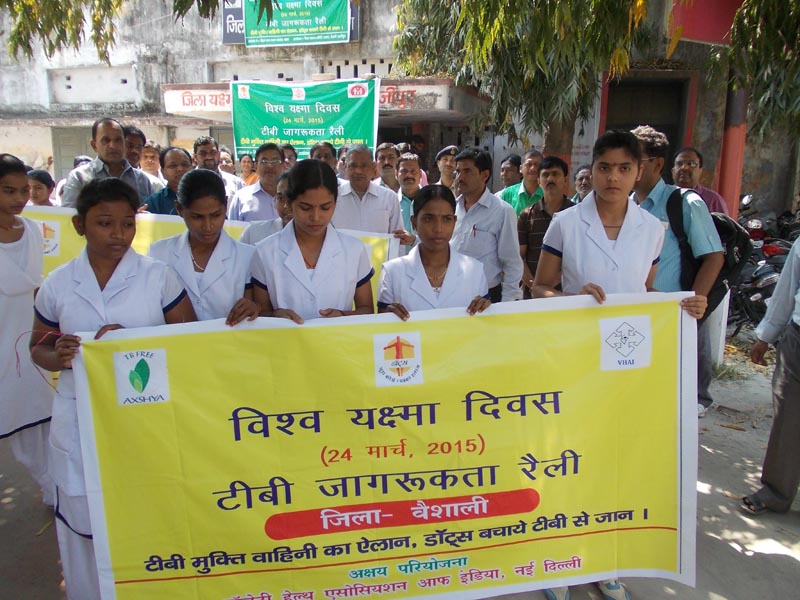


Overview
Programme Impact
PROJECT AXSHYA’s extensive Advocacy, Communication and Social Mobilisation interventions have had a far reaching impact. Since January 2018 to March 2021, the project has covered around 1 million households and reached almost 5 Million population through Axshya Samvad with TB information and services. The project has identified more than 1.6 lakh Presumptive TB patients and facilitated testing of over 93% identified presumptive TB patients through Smear and CBNAAT testing resulting in diagnosis of more 21000 TB patients and among diagnosed more than 90 percent patients were put on treatment.
More than 50 local level NGOs and almost 1000 individual community volunteers have been engaged with the project and these NGOs and ICVs were given trainings on awareness generation, active case finding for early diagnosis and treatment at the doorstep for hard-to- reach communities. More than 750 Active community surveillance units have been established across 25 Districts with the goal of creating awareness about TB and prevention of new TB cases. The project has engaged 32 project supported X-ray Labs at District level to facilitate free of cost X ray diagnosis to vulnerable and hard to reach communities. More than 2200 patients were linked to project supported X-ray facilities and out of tested 30% were found to be positive and were put on treatment.
Over 4500 TB patients were empowered by making them aware of their rights and responsibilities, more than 37% of whom were women.
Key Activities
Under Project Axshya, health camps are extensively being organized in the project KAP population for active case finding and awareness on TB prevention & care. This platform is also used to provide information on TB infection, transmission, prevention and care; along with information on services of the programme. Each individual attending the camp is screened for symptoms of TB. Any presumptive TB patient identified through the health camps are linked with Direct Microscopy Centers (DMCs) for sample collection and direct transportation to these centers.
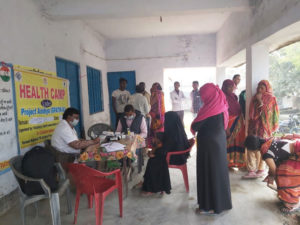
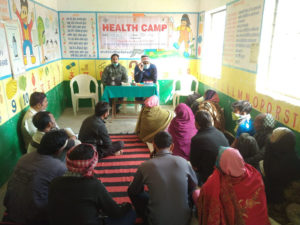
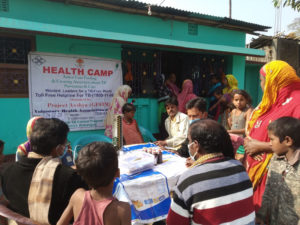
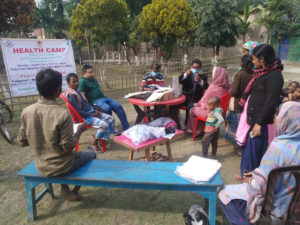
Axshya SAMVAD for “Active TB case Finding” (ACF) is an opportunity to sensitize the population and create awareness on tuberculosis. It also helps to identify presumptive TB patients through house visits. The identified Presumptive TB patients (PTBPs) are then provided referral or sample collection and transportation services; with an objective of early identification and ensuring timely medical treatment of the patents.
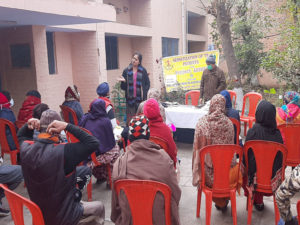
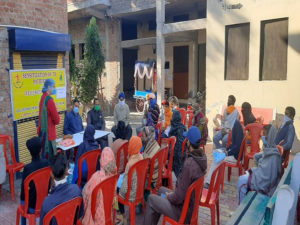
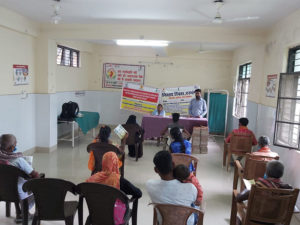
Under Axshya, Key Affected Population (KAP) refers to vulnerable and marginalised population. In order to successfully implement the project activities, project staff prepares a comprehensive district mapping profile, understands the concept of vulnerable marginalised populations and then map these populations in the district. These populations include contact of TB patients, people living with HIV (PLHIV), migrants/slum dwellers, people from congregate settings like prison, tribal areas, hard-to-reach areas etc. District mapping is the base for all Axshya interventions in the district.
Public Health Surveillance (PHS) plays a pivotal role in controlling communicable diseases like TB in the community at the primary stage.. Active surveillance provides the most accurate and timely information, but it is a challenge to establish a robust system in resource constraint settings. Hence, active community level surveillance for TB has been planned as a key flagship activity in project Axshya during the current grant period.
To address the gap in diagnosis, project Axshya is implementing screening of all patients attending OPDs of government hospitals and also among patients admitted in the Inpatient Department (IPD). Following identification of Presumptive TB patient through verbal screening, the volunteer accompanies them to the hospital DMC for examination.
The project has supported the formation of District TB Forums (DTF) to empower and engage the TB affected community. The DTFs have been formed with representatives from TB affected patients (cured /on treatment) and interested civil society members such as local journalists, lawyers, NGO representatives, opinion leaders, people’s representatives etc. The project is empowering and providing an opportunity to the DTFs to interact with the District Programme Managers to address the challenges faced by TB patients in accessing quality diagnostic and treatment services.
Project has observed that unless there is an established system of sample collection and transportation/ accompanied referrals; most of the presumptive patients do not avail diagnostic and other health care services. Hence, project Axshya is focussing on establishing sample collection, its transport and accompanied referrals for almost all ACF interventions to expedite the process of treatment.
Project Axshya has demonstrated the need of Sputum Collection & Transportation (SC&T) for almost all the Active Case Finding interventions over all phases of implementation. RNTCP has made smear examination available, free of cost at all government facilities and project Axshya is supporting linkages of identified KAP populations to these laboratories by either SC&T or accompanied referrals. Project Axshya has provisioned procuring CXR services from private sector wherever indicated as per the project guidelines. Project Axshya beneficiaries are supported financially for transport to ensure that a maximum number of these PTBPs are tested for TB diagnosis through CXR.
Project activities in particular district levels are carried out with the support of NGO partners, community volunteers, Active Community Surveillance Units (ACSUs) and with the community including TB champions (cured TB patients).
The project has direct dialogues with the target community through community members and village opinion leaders to:
- Sensitize the presumptive TB patients (PTBPs) for their check-up for the suspected TB and provide them information about the health care facilities.
- Demystify locally prevalent myths and misconceptions about TB.
- Sensitize, disseminate and promote adoption of the Patients’ Charter for TB care among all stakeholders.
- Counsel all the identified TB patients for completing their treatment and to have regular follow up.
- Facilitate Direct Bank Transfer (DBT) for the identified TB patients for their financial support with the RNTCP.
- Create a platform to END TB strategy by getting TB free village/Panchayat and Block through project activities.
Axshya project has been awarded A-1 grading by the Global Fund during its implementation of first three phases from April 2010 to December 2017.
The focus of the project is to ensure complete treatment of the TB patients identified through intervention with regular liaison and to facilitate the TB patients with the welfare services available. The project activities are planned in consultation with the RNTCP staff to make effective outreach and to make universal access to TB services in the target population.
- Axshya Samvad: Axshya Samvad in an innovative intervention to increase awareness about TB and identify and link presumptive TB patients to TB services through house to house visits by community volunteers. For this activity we identify vulnerable and marginalized populations having poor access to health services in slums, tribals, migrants, hard to reach areas. Each district was given 1500 household to cover in a month and, thus, 18,000 households were covered in the year.
- Active Community Surveillance Units (ACSU): We identify the community volunteer from the same community. She/he is generally a cured TB patient, individual, DOT Provider who has access to the TB patients from that area which helps us to reach to the contact of TB patients. A population of 1,50,000 in a district are reached through this process. This is done through linkage with ANMs, ASHAs, Anganwadi workers, TB Survivor, DOT Provider and RHCP. Contact tracing of TB patients wherein screening during the surveillance is done to decrease missed TB cases.
- Fast Tracking of TB patients: The project has placed a community volunteer at the Out Patient Department of the hospital to fast track the people accessing the hospitals to TB services. The presumptive TB patients are sent at the designated microscopy center (DMC) for smear examination. The volunteer also ensures examination of presumptive TB patient from the In Patient Department. Smear microscopy/Chest X Ray/Genexpert (CBNAAT) is done for all the patients. The identified TB patients are then initiated on treatment.
- Health Camps: The health camps are conducted in the key affected population and congregated settings in close collaboration with the National Health Mission (NHM). Health Camps provide general medical services through Medical Officers from RNTCP or Private Qualified Doctor and paramedical staff. The community is screened for the symptoms of TB. The presumptive TB patients are sent for check-up for early screening of TB. The health camp is planned to cover the last mile of the last village in a district. The project staffs ensure that all identified TB patients get complete treatment and follow up.
Success Stories
Case Study
- Axshay Samvad at Morena, Sabalgarh
- Axshya Samvad at needy pocket- Munger, Bihar
- A privilege to underprivileged- Chandauli, UP
- Defeating TB- Sangrur, Punjab
- Voices from periphery to core
- Case Study – Direct Bank Transfer
- Case Study – MP Central Jail Satna
- Story – TB Patient Mr. Lalan Mahldar,Katihar-Bihar
- Story – TB Patient Mr. Ajay Kali Mahal
- Story – TB Patient Mr. Mangi Lal Bheel
- Story – TB Patient Mr. Khetaram
- Success story for Mining Labour – Jodhpur
- Barmer – Hathla Village At Indo Pakistan Border


